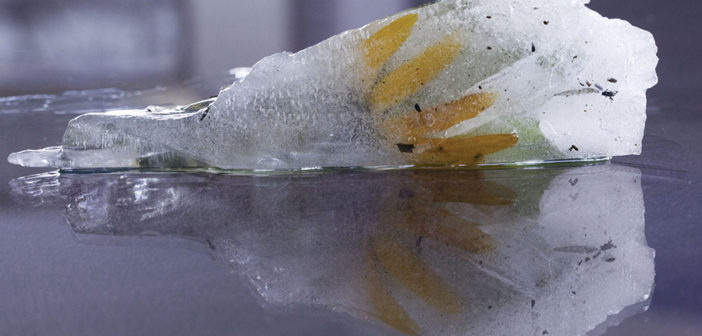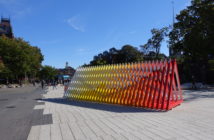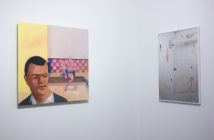In her solo exhibition at Kingston Gallery, Fare Well: The Art of Ending, on view August 30 - October 1, Kathleen Gerdon Archer’s photographic work demonstrated a masterful ability to blend abstraction, process, and place.
Gerdon Archer credits the inspiration for these photographs to rock formations left by receding glaciers that once covered New England. To create the final product, she collects various objects and freezes them, according to Kingston’s website, “layer by layer, to build a conglomerate [structure].” After these new arctic objects are created, she photographs them as they melt. Finally, these ephemeral moments manifest as large format polypropylene prints, mounted on sintra under Plexiglas. This entire process, seemingly lengthy and introspective, produces images that appear like glossy, abstract paintings from afar. They obscure the original object hidden within the watery mass and layer properties unto it that bestow it with a new intrigue, the most obvious of which is texture composed of bubbles, cracks and lines.
Through an artist statement on the wall of the gallery, Gerdon Archer introduced these images as “photographic reliquaries” where she combined “personal tokens from a lost family member” in layers. The first is “rock taken from the place I knew them...the second is indigenous plant matter...a row of bird and flower seed,” onto which she places “torn photographs of family and friends, then personal memorabilia” like jewelry and birth and death announcements. Though the process is highly personal for the artist, Gerdon Archer’s eye for capturing the “right” moment produced work that could that still engaged the casual visitor. This mysterious, elegiac world had avenues of accessibility, from its grounding in the New England environment, to its themes of loss and attachment to ephemera.
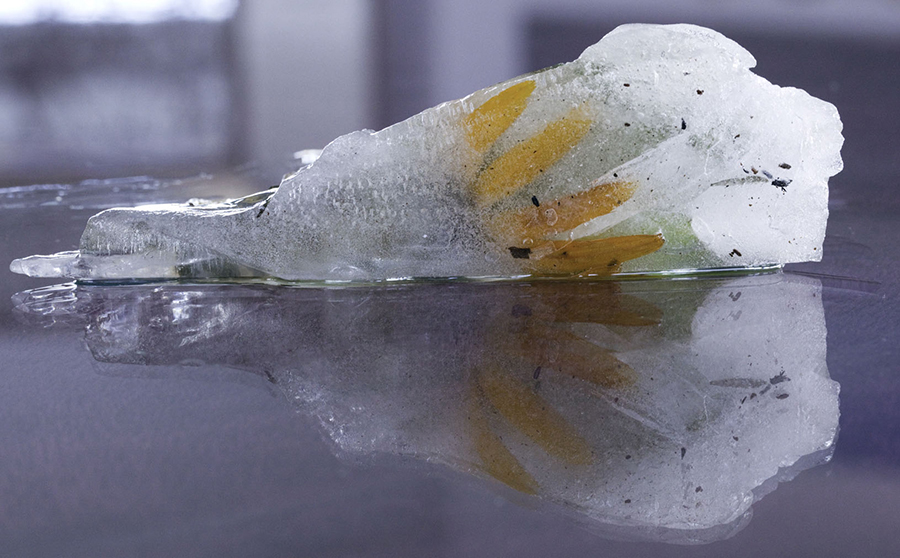
Kathleen Gerdon Archer, Insight or Afterglow, 2017 Polypropylene Print mounted on Sintra under Plexiglas, 20" x 32" Edition of 25. Courtesy of Kingston Gallery.
Insight or Afterglow, 2017, was placed at Kingston’s entry. As I progressed through the show, it became clear this smaller piece deviated from other work. It appeared to be the only photograph that was zoomed out enough to reveal part of the artist’s process. In it, Gerdon Archer captures one of her blocks of ice almost completely melted. Though more visual information is withheld, we are able to see the state of the ice as it must have slowly revealed a flower encapsulated within its depths. There is also a glimpse of place in this image - perhaps the artist’s studio - that others in the grouping lacked.
The pairing of Sleep is Another World, an image of white roses, with the more foreign-looking A Mosaic Spinning, is quite clever. Both depict organic objects, but the dialogue between them is in two different languages, alluding to the nuance in Gerdon Archer’s process. While Mosaic Spinning is reminiscent of naturally-occurring patterns that are unwittingly trapped as a pond freezes over, Sleep is Another World speaks in more refined, poetic tones, ostensibly imbued with artistic intent. This juxtaposition, like many others in the show, politely asked viewers to slow down and look within. The longer you look, the more the mind finds recognizable patterns, such as faces of people and animals.
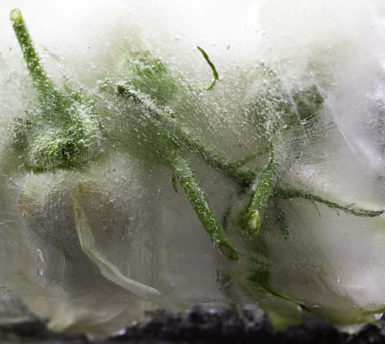
Kathleen Gerdon Archer, Sleep is Another World, 2017 Polypropylene Print mounted on Sintra under Plexiglas, 42" x 48" Edition of 25. Courtesy of Kingston Gallery.
I found myself struggling to peer within the photographs, as if I too, was waiting for the ice to melt. Ambiguity lead to fascination and a false feeling of confidence - that we must be able to figure out what is inside, even as the artist holds her cards close to her chest. Certainly, the decision to use photography implies there is a “truth” hidden within. This instinct compels us to remain present, even if we never have the chance to see each “reliquary” in its entirety.
In Kingston’s second, smaller room, there were five photographic works and a collage on the floor. The subjects trapped within the ice seemed more personal here - most of them being photographs of people. The collage on the floor, which was beneath Not at Ease in This World, 2017, contained numerous snapshots, layered and frozen under glossy Plexiglass. The overall effect implied that these photographs melted in an artificial pool at the foot of Not at Ease. It was an interesting play on the idea of Gerdon Archer’s process, but read a bit like an appendage that lacks the haunting visual appeal of the other, large format works.
Only Think We Remember Knowing, These Years of Days, and Not at Ease in This World all skillfully walked the line between personal and removed. It is really in these photos, with the assumption that we are looking at the artist’s keepsakes, that the title, Fare Well: The Art of Ending, comes back to us. These works force questions, such as
What does the act of freezing do to the object?
How does this manipulation of the object change the way we see or interpret these keepsakes?
How does she find the right moment to capture the disintegration of these icy tombs?
If the act of freezing is generally meant to preserve things, is the artist preserving her memory or destroying it?
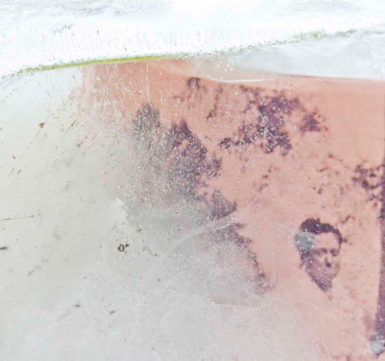
Kathleen Gerdon Archer, Not at Ease in this World, 2017 Polypropylene Print mounted on Sintra under Plexiglas, 45" x 48" Edition of 25. Courtesy of Kingston Gallery.
In this body of work, Gerdon Archer strikes a delicate balance between chance and artistic instinct, capturing the ephemeral in a compelling manner. There is something melancholy about the act of creating these icy “reliquaries” and watching them melt, like creating a time capsule that will not last. As spectators, we are limited in our understanding of the meaning of the process for the artist, but we can appreciate her instinct to fix a moment in time.

